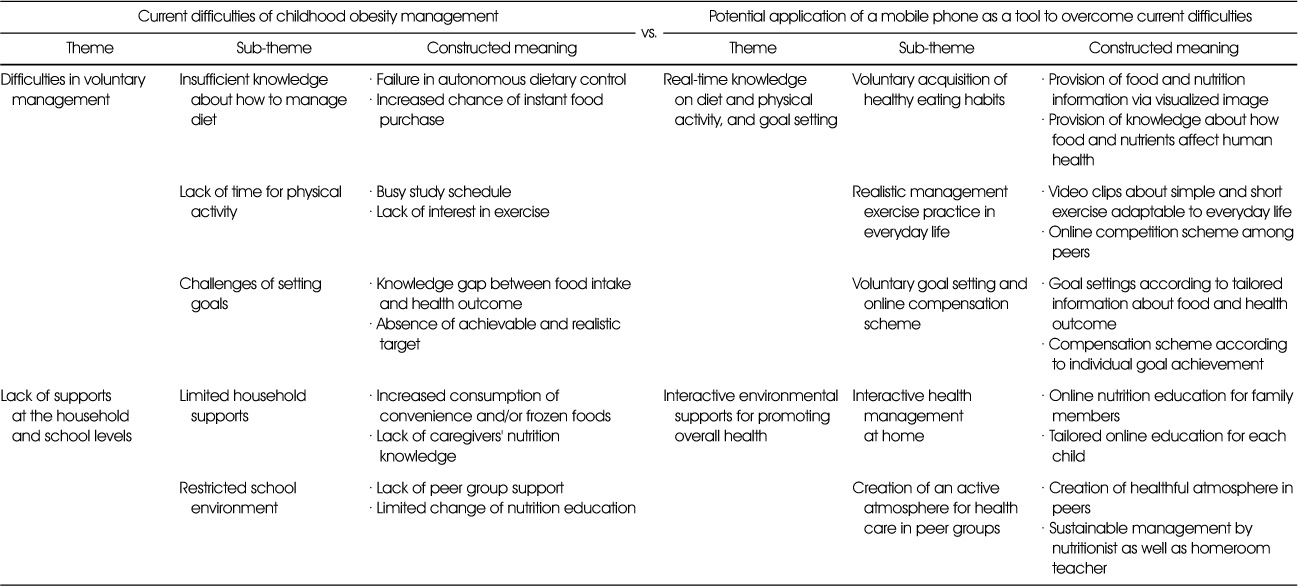Articles
- Page Path
- HOME > Korean J Community Nutr > Volume 24(2); 2019 > Article
-
Research Article
- A Qualitative Study on the Potential Utilization of a Mobile Phone for Obesity Management in Elementary-School Children : Parents Perspective
-
Bo Young Lee
 , Mi-Young Park
, Mi-Young Park , Kirang Kim
, Kirang Kim , Jea Eun Shim
, Jea Eun Shim , Ji-Yun Hwang
, Ji-Yun Hwang
-
Korean Journal of Community Nutrition 2019;24(2):117-126.
DOI: https://doi.org/10.5720/kjcn.2019.24.2.117
Published online: April 30, 2019
1Department of Foodservice Management and Nutrition, Graduate School, Sangmyung University, Seoul, Korea, Graduate Student.
2Department of Food and Nutrition & Research Institute of Obesity Sciences, Sungshin Women's University, Seoul, Korea, Research Professor.
3Department of Food Science and Nutrition, Dankook University, Cheonan, Korea, Professor.
4Department of Food and Nutrition, Daejeon University, Daejeon, Korea, Professor.
5Department of Foodservice Management and Nutrition, Sangmyung University, Seoul, Korea, Professor.
- Corresponding author: Ji-Yun Hwang. Department of Foodservice Management and Nutrition, Sangmyung University, 20 Hongjimun-2-gil, Jongno-gu, Seoul 03016, South Korea. Tel: (02) 781-7521, Fax: (02) 2287-0104, jiyunhk@smu.ac.kr
Copyright © 2019 The Korean Society of Community Nutrition
This is an Open-Access article distributed under the terms of the Creative Commons Attribution Non-Commercial License (http://creativecommons.org/licenses/by-nc/3.0/) which permits unrestricted non-commercial use, distribution, and reproduction in any medium, provided the original work is properly cited.
- 1,231 Views
- 2 Download
- 2 Crossref
Figure & Data
REFERENCES
Citations

- Current Barriers of Obesity Management of Children Using Community Child Care Centers and Potential Possibility of Utilizing Mobile Phones: A Qualitative Study for Children and Caregivers
Bo Young Lee, Mi-Young Park, Kirang Kim, Jea Eun Shim, Ji-Yun Hwang
Korean Journal of Community Nutrition.2020; 25(3): 189. CrossRef - Consumers’ Impulse Buying Behavior on Instagram: Examining the Influence of Flow Experiences and Hedonic Browsing on Impulse Buying
Forough Shahpasandi, Azim Zarei, Mohsen Shafiei Nikabadi
Journal of Internet Commerce.2020; 19(4): 437. CrossRef
General characteristics of participants
Potential application of a mobile phone as a tool to overcome the difficulties of obesity management in elementary school students from the perspective of parents

 KSCN
KSCN


 Cite
Cite


